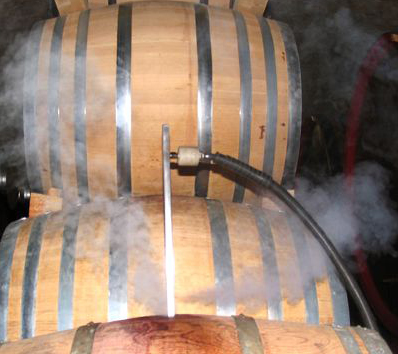Boiling
Boiling the equipment in water is the most fundamental way to sanitize equipment. No chemicals are needed, and a container big enough to hold the equipment, water, and a heat source is all the winemaker needs. This may seem like a simple and cheaper choice if you are just starting out in winemaking, but we do not suggest using this technique.
 Benefits: no chemicals required, easily available, water is cheap-Benefits: time consuming, large containers for boiling, risk of burning, drawbacks
Benefits: no chemicals required, easily available, water is cheap-Benefits: time consuming, large containers for boiling, risk of burning, drawbacks Chlorine
Chlorine is readily available and is a good cleaner and disinfectant in the form of household bleach. It serves as a decent sanitizer for glass equipment, but should not be used on plastic equipment. Since the plastic will absorb chlorine, undesired flavors will be created in your wine.
Benefits: readily available in the form of household bleach, inexpensive-Disadvantages: can be used on plastic, textile ruins, stainless steel corrodes,
Iodophorus
The food service industry and the medical industry use Iodophor to sanitize equipment. It is a detergent with iodine, germicide and sanitizer. It is a no-rinse sanitizer and very simple to use overall, on the basis of practicality of use. You can, for instance, use 1⁄4 ounce per 2 1⁄2 gallons of water for a 12.5 ppm solution when using an Io-Star Iodophor Sanitizer. You should apply your equipment to the solution at this stage of concentration and it takes approximately 10 minutes to sanitize. Then allow the appliance to drip dry for another 10 minutes prior to use.
Benefits: economical, no-rinse sanitizer-Benefits: harmful in high concentrations, fabric stains, skin
Phosphate Based Sanitizers
When someone calls Quality Wine and asks for guidance on a sanitizing solution, an acid-based product-Star San Acid Sanitizer for Surface Sanitation-is the first approach we turn to. This is a no-rinse sanitizer solution that is very easy to use and maintain. It is made of phosphoric acid, which is food-grade and healthy for humans and the environment.
Benefits: no-rinse sanitizer, fast sanitizing time-Benefits: harmful in high concentrations, wearing protective clothing
The Powder of Potassium Metabisulfite
By inhibiting bacteria and wild yeast, potassium metabisulfite sanitizes the machinery. It releases sulfur dioxide when mixed with water, which is a potent antiseptic. You will note a strong sulfur odor after applying the powder to water, and people allergic to sulphites may be affected by its potency. As no additional rinsing with clean water is needed, this method is considered a cost-effective sanitizing rinse.
Benefits: long shelf life, economical, no rinsing required-Benefits: precise calculation skills required, some people are allergic to sulfites.
Whatever sanitizing agent you decide to use during your winemaking process, during the sanitation cycle, it is important to never get lazy.





